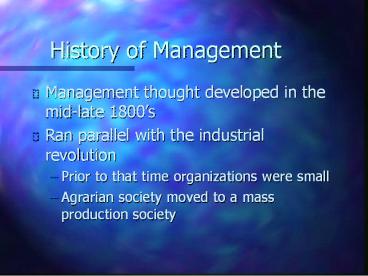History of Management - PowerPoint PPT Presentation
Title:
History of Management
Description:
History of Management Management thought developed in the mid-late 1800 s Ran parallel with the industrial revolution Prior to that time organizations were small – PowerPoint PPT presentation
Number of Views:608
Avg rating:3.0/5.0
Title: History of Management
1
History of Management
- Management thought developed in the mid-late
1800s - Ran parallel with the industrial revolution
- Prior to that time organizations were small
- Agrarian society moved to a mass production
society
2
Five Viewpoints of Management
- Classical- late 1800s
- Bureaucratic, Scientific, Administrative
- Behavioral- 1930s, 40s, 50s
- Systems-50s, 60s, 70s
- Contingency-60s, 70s, 80s
- Quality-80s, 90s
3
History of Management Thought
2.2
Quality Viewpoint
Contingency Viewpoint
Systems Viewpoint
Behavioral Viewpoint
Traditional Viewpoint
1890 1900 1910 1920 1930 1940 1950
1960 1970 1980 1990 2000
Adapted from Figure 2.1
4
Assumptions of Viewpoints
- Continuous viewpoints do not replace each other
but have differing perspectives - All differ on how they view
- behavior of individuals
- organizational goals
- issues that the organization faces
- how those issues should be resolved
5
Bureaucratic Management
- Max Weber wanted to eliminate nepotism, and
favoritism in organizations - A rational method-scientific and logical approach
to business
6
Negative View of Bureacracy
- Bureaucracies strip all relations of content but
that which is strictly applicable to the
attainment of organizational ends (Lincoln,
1982 21) - How we view bureaucracy
- School
- Taxes
- Government
7
Aspects of Bureaucracy
- Formal Rules for uniformity
- Impersonality in hiring, evaluation, etc. rather
than social status, or personality - Division of labor into specialized areas
- Hierarchy
- Set Decision/Power Structure
8
Hierarchical Organization Chart
2.3
Top Manager
Middle Manager
Middle Manager
First-Line Manager
First-Line Manager
First-Line Manager
First-Line Manager
Work Group
Work Group
Work Group
Work Group
Work Group
Work Group
Work Group
Work Group
Adapted from Figure 2.2
9
Continuum of Bureaucratic Orientation
2.4
U.SPostalService
Dreamworks SKG
Coca-Cola
Hoechst-Celanese
Construction Firms
UPS
LowBureaucraticStructure
HighBureaucraticOrientation
Mid-RangeBureaucracy
Adapted from Figure 2.3
10
Positive and Negative Aspects
- Positive aspects
- efficiency
- consistency
- set lines of communication
- Costs
- follows rigid rules for the sake of rules
- slow or change
- cant respond to a dynamic environment
11
Scientific Management
- Fred Taylor
- Time and Motion studies
- Proposed One most efficient way for completing
a task - Employees are economically motivated
- Formen
12
Gilbreths and Therbligs
- Frank and Lillian
- Broke tasks down by each motion called
therbligs - Used motion video
- Lillian later played an instrumental role in
behavioral movement
13
Administrative Management
- Management is a science that can be learned
- Division of Labor
- Authority of Managers
- Discipline
- Unity of Command
- Centralization of power
14
Behavioral/Human Relations
- People and their behaviors matter within the
organization - In light of that assumption this school looks at
how managers do their job in order to affect the
behavior of subordinates
15
Major Players
- Follet
- Involvement of workers
- Continuous aspect of management
- Barnard
- Organizations are social systems
- Acceptance theory of authority
- understand, believe, see benefits
16
Hawthorne Studies
- Western Electric Studies
- Mayo
- Theorized that workers would be more productive
if given favorable working conditions - Theory did not hold, but......
- Found that the attention given to workers was the
variable that affected performance
17
Behavioral Viewpoint Summary
- Employees are social beings, not just
economically motivated - The social aspect of humans must be addressed by
management - Fulfillment of needs and participation will
motivate employees
18
Systems Viewpoint
- Organizations are machines that operate within an
environment - Inputs-human, financial, physical, and info
- Processes
- Outputs-products and services
- A change in one part of the system affects the
whole system
19
Systems
- Closed-limited interaction with the environment,
only at input and output portals - Open-systems- all parts of the organization
interact with the environment - Subsystems- parts within the organization
- groups (formal and informal), individuals,
departments, and divisions
20
Basic Systems View of Organization
2.7
Environment
INPUTS Human, physical, financial, and
information resources
TRANS-FORMATION PROCESS
OUTPUTS Products andServices
Feedback
Loops
Adapted from Figure 2.4
21
Contingency Approach
- It Depends!
- Must assess the environment and use aspects of
the three previous approaches in combination to
maximize performance - No prescriptive One best way
22
Contingency Viewpoint
2.9
- Behavioral Viewpoint
- How managers influence others
- Informal Group
- Cooperation among employees
- Employees social needs
- Systems Viewpoint
- How the parts fit together
- Inputs
- Transformations
- Outputs
- Traditional Viewpoint
- What managers do
- Plan
- Organize
- Lead
- Control
- Contingency Viewpoint
- Managers use of other viewpoints
- to solve problems involving
- External environment
- Technology
- Individuals
Adapted from Figure 2.6
23
Quality and Ed Demming
- Society has passed the point of concern with
quantity of production, because for the most part
quantity has been maxed-out - Quality is now the issue when performance is
discussed - Demming pioneered the quality movement, and was
ignored in the US
24
Demmings Story
- Developed the quality idea
- Was rejected by US companies
- Sold his ideas in Japan
- Japan excelled in automobile, and technological
quality - US companies had to play catch-up in the 1980s
25
Demmings Principles
- Quality at the beginning will lead to lower costs
and greater productivity in the long-run - use of statistical methods to assess quality
- all employees are responsible for quality checks
- leads to company image, lower costs, less product
liability
26
Importance of Quality
2.10
Lower Costs Higher Market Share
PositiveCompany Image
QUALITY
Decreased Product Liability
Adapted from Figure 2.7































